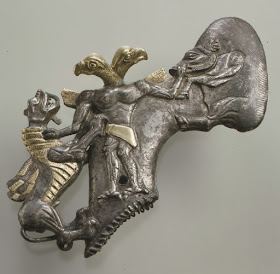In 2011, this beautiful object was sold for 97,000 pounds sterling...A Bactrian gold stamp seal, c. 2200-1900 BC...
Official description: "...central figure of a winged giant, with muscular human torso and legs, the head and talons of an eagle, wearing a short open tunic with wide belt, and a pendant necklace, grasping in each hand an inverted ibex..."
What the heck is the meaning of this scene? Here is the stamp print which makes the scene depicted on the stamp much clearer...
Well to understand this, we need to first identify the two animals the "winged giant" is holding in his hands. They are not Ibex goats...They are not goats at all. They are wild sheep. Mouflons...
Look at the horns...
Bezoar goat, native to Bactria.
Mouflon sheep, native to Bactria...
But I am just being picky...It actually makes no difference whether these are Bezoars or Mouflons, from the point of view of understanding this scene...
This is because both species have the same mating season, which starts in Oct-Nov, at the beginning of the rain season in Bactria...And the beginning of winter...
You can see that in Bactria, the climatic year is roughly divided into hot and dry and cool and wet parts
Both animals were used in Eurasia as animal calendar markers marking the beginning of the rain season and the beginning of winter...The rejuvenation of nature...Like on this vase design from Jiroft culture, just a bit down south from Bactria...
Both animals mating season last throughout the winter, Nov-Dec-Jan...Which is also the time when local vultures have their mating season....
Which is why vulture, and more specifically, a vulture dude, like our winged giant, became a symbol of the rain season...Basically the vulture (eagle) dude is the rain god...I talked about this in my post "Eagle calendar markers"...
Here is another Bactrian seal, with the same eagle dude, this time actually holding two Bezoar goats...Just so you see that Bezoars and Mouflons are actually interchangeable as calendar markers...
I talked about this seal in my post "Fluffy"...
And here is the same eagle dude, this time with two heads, on an axe head from Bactia...
I talked about this amazing artefact in my post "Double headed eagle"...
Why two heads? Because the main vulture mating ritual is the synchronized flying...
Which from the ground looks like this: A double headed eagle...
So...Another very very cool example of animal calendar markers, which are found all over Eurasia and North Africa...
To read more about ancient animal and plant calendar markers, start here…then check the rest of the blog posts related to animal calendar markers I still didn't add to this page, and finally check my twitter threads I still didn't convert to blog post...I am 9 months behind now...













No comments:
Post a Comment